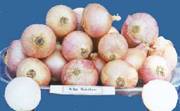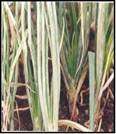Bellary onion (Allium cepa var. cepa)
Alliaceae
Varieties
Bellary Red, Pusa Red, NP 53, Arka Niketan, Arka Kalyan, Arka Lalima, Arka Kirthiman, Arka Pitamber, Arka Kalyan, Agri Found Light Red Agri Found Dark Red and Rose onion (small) are commonly cultivated.
 |
 |
 |
| Agri Found Light Red |
Agri Found Dark Red |
Arka Niketan |
Soil
Red loam to black soils with good drainage facilities is highly preferred for bellary onion cultivation. The pH of 5.8 - 6.5 with mild season is preferred.
Season
May – June is best season for planting.
Seed rate
10 kg/ha seeds are required for a hectare.
Seed treatment
Treat the seeds with Azospirillum @ 400 g/kg of seed using rice gruel as adhesive, dry under shade for 30 minutes and sow them.
Apply VAM 1 kg/sq. m in the beds along with FYM 10 kg/sq.m before sowing.
Preparation of main field
Plough the land to get a fine tilth and incorporate 25 t/ha of FYM at the time of last ploughing. Form ridges and furrows at 45 cm spacing.
Planting
Plant 45 days old seedlings at a spacing of 10 cm apart on both the sides of the ridges.
Irrigation
After establishment irrigate at weekly intervals.
Application of fertilizers
Apply FYM 25 t/ha, Azospirillum 2 kg and Phosphobacteria 2 kg/ha, N 50 kg, P 150 kg and K 75 kg/ha as basal dose and N 50 kg/ha as top-dressing is done at 30 days after planting. Apply Zinc sulphate as basal dose @ 50 kg/ha at the time of last ploughing.
Plant protection
Pests
Thrips and onion fly
Thrips and onion fly can be controlled by spraying Methyl demeton 25 EC 1 ml/lit or Dimethoate 30 EC 1 ml/lit with Teepol 0.5 ml/lit.
 Thrips
Thrips Cutworm
Cut worms can be controlled by drenching the soil with Chlorpyriphos @ 2 ml/lit.
Nematode
Application of Carbofuran 3 G 1 kg a.i./ha or Phorate 10 G 1 kg a.i./ha at 10 days after transplanting controls the nematode infestation.
Disease
Leaf spot
Leaf spot disease can be controlled by spraying Mancozeb 2 g/lit or Copper oxychloride 2 g/lit. Add 1 ml of Teepol to 1 lit of the spray fluid.
Harvest
Irrigation is stopped on a week before harvesting. Harvest is done when 75 % of leaves dried off or top fall stage.
Yield
The crop yields about 15 – 18 t/ha in 140 – 150 days.
Market Information
| Crop Growing districts |
: |
Perambalur,Trichy,Thiruppur,Dindigul,Namakkal,Tirunelveli |
Major markets in Tamil Nadu |
: |
Ottanchathiram, Koyambedu, Dindigul, Coimbatore |
Grade Specification |
: |
Colour and Size
Extra large onion (>6 cm dia.), Medium (4-6 cm dia.),
Small (2-4 cm dia.),
Light Red, light purple colour |
Source
1. http://nrcog.mah.nic.in/NOnionvar.html
Big onion and aggregatum onion production through fertigation
Quality seedling production
- The seedlings of big / common bellary onion are produced in raised nursery beds. Nursery area of 12.5 cents with slanting slope of 2% is required for the seedling production to cover 1 ha.
- Unlike other transplanted vegetables, the nursery area of open / protected – raised beds may be used since, the seeds are too small and the number of seedlings requirement is also very high.
- Raised beds of 30cm height and convenient length at an nterval of 30cm between beds must be formed for sowing the seeds.
- The beds are inoculated with Arbuscular mycorrhizae @ 1 kg / sq. m.
Seed treatment and seed rate
8-12kg of onion seeds are required to raise seedlings for one hectare of land. The seeds are treated with Pseudomonas fluorescens @ 10g/ kg of seeds.
Sowing
- The seeds of onion are small, and hence the seeds should be mixed with fine sand and sown in lines 10 cm apart.
- After sowing, the seeds are covered by thin layer of sand and then by paddy straw. The nursery is watered through rose can twice a day regularly.
- On tenth day, copper oxychloride @ 2g / litre of water is sprayed to protect the seedlings from damping off disease.
Drip irrigation
- Installation of drip system is done with main and sub-main pipes and the inline lateral tubes are placed at an interval of 1.5 m.
- The drippers in lateral tubes are placed at an interval of 60 cm and 50cm spacing with 4LPH and 3.5 LPH capacities respectively.
Field preparation
- The field selected for planting should be ploughed thoroughly by using chisel plough, disc plough and cultivator.
- FYM @ 25t / ha and 75% of the total recommended dose of single superphosphate (285kg.) Azospirillum, phosphobacteria 2 kg / ha and Pseudomonos 2.5 kg / ha along with FYM 50 kg and neem cake @ 100g are applied before last ploughing.
- Along with biofetilizers 50kg each of zinc suphate and ferrous sulphate are applied before last ploughing.
- Raised beds of 1.2 m width and 30 cm height are formed for transplanting.
- Drip irrigation is done @ 8-12 hours depending upon the soil condition to get field capacity.
Planting
- Transplanting is done in rows at the spacing of 15 cm between rows (of 7 rows within the bed) and 10 cm between plants.
- A total population of 4,70,000 seedlings are required to cover one hectare of land.
After care
- Drip irrigation is done @ 1-2 hours per day depending upon the soil and climatic condition.
- Weeding: First weeding is done on 30th day after transplanting. Then weeding is done as and when necessary.
- Fertigation: For big onion, 60:60:30kg of NPK/ha is applied throughout the cropping period. The splits are approximately once in every 3 days.
Harvesting and post harvest management
- The harvesting is done 75 to 160 days depending upon the varieties.
- The irrigation is stopped 15 days before harvesting and sprayed with 2500 ppm of maleic hydrazide. This will prevent sprouting of the bulbs in storage, by which they can be stored even for 6-7 months.
- The correct time of harvest is one week after 50% top fall. After lifting, the bulbs with tops should be cured in shade for 10-15 days before storage to remove field heat. Then proper sorting and grading is done.
Fertigation Schedule
Recommended dose: 60:250: 250 kg / ha
| Stage |
Crop stage |
Duration in days |
Fertilizer grade |
Total Fertilizer (kg/ha) |
Nutrient applied |
% of requirement |
| N |
P |
K |
N |
P |
K |
| 1 |
Sowing
to establishment
stage |
10 |
19:19:19
+MN
Urea |
15.79
6.50 |
3.00
3.00 |
3.00
- |
3.00
- |
10.00 |
5.00 |
10.00 |
| Subtotal |
6.00 |
3.00 |
3.00 |
|
|
|
| 2 |
Vegetable stage |
25 |
12:61:0
13:0:45
Amm.So4 |
7.46
13.20
76.67 |
0.89
1.72
15.33 |
4.55
-
- |
5.94 |
30.00 |
7.50 |
20.00 |
| Subtotal |
17.94 |
4.55 |
5.94 |
|
|
|
| 3 |
Bulb formation stage |
25 |
12:61:0
13:0:45
Amm.So4 |
7.46
19.80
72.33 |
0.89
2.57
14.47 |
4.55
-
- |
8.99
-
- |
30.00 |
7.50 |
30.00 |
| Subtotal |
17.93 |
4.55 |
8.99 |
|
|
|
| 4 |
Bulb development stage |
30 |
19:19:19
MN
Amm.So4 |
15.79
19.80
62.00 |
3.00
2.57
12.40 |
3.00
-
- |
3.00
8.91
- |
30.00 |
5.00 |
40.00 |
| Subtotal |
17.97 |
3.00 |
11.91 |
|
|
|
| |
Total duration |
90 |
|
|
59.84
(or)
60.00 |
15.00 |
27.76
(or)
30.00 |
100 |
25 |
100 |
75% of RD of Phosporous applied as super phosphate = 45 kg x 6.25 = 281.25 kg/ha
1. 19:19:19 = 32 kg/ha 2. 12:61:0 = 14.92 kg / ha (or) 15.00 kg /ha
3. 13:0:45 = 53 kg / ha 4. Urea = 7 kg / ha 5. Ammonium SO4 = 211 kg / ha
Effect of Endo root soluble and Mycorrhizae on Onion
- Apply 1000g Endo Roots Soluble in two splits doses at 15 DAT and 45 DAT along with 100% N and K and 50% P for higher yield and saving of phosphorous
- Apply mycorrhiza roots 1000g in two splits at transplanting and 30DAT along with 100% N and K and 50% P for higher yield and saving of phosphorous.
Updated on : 26.08.2013 |




